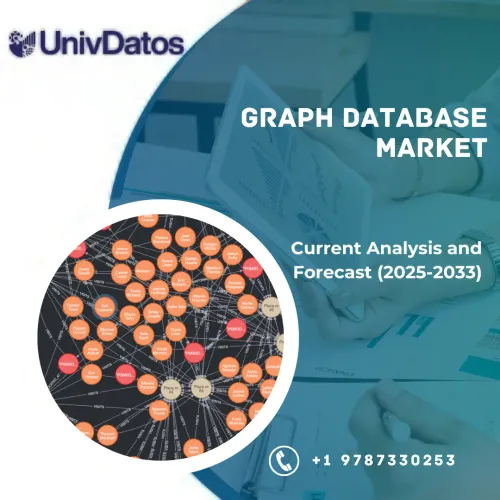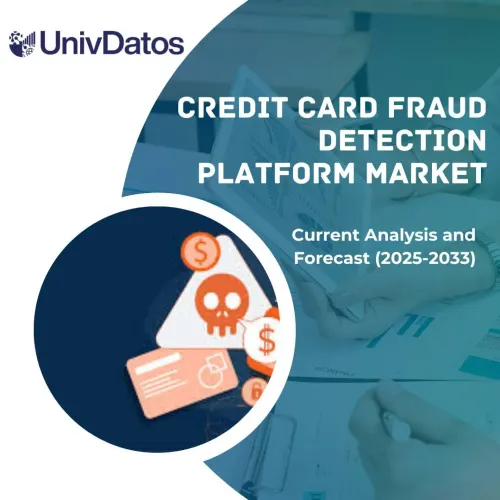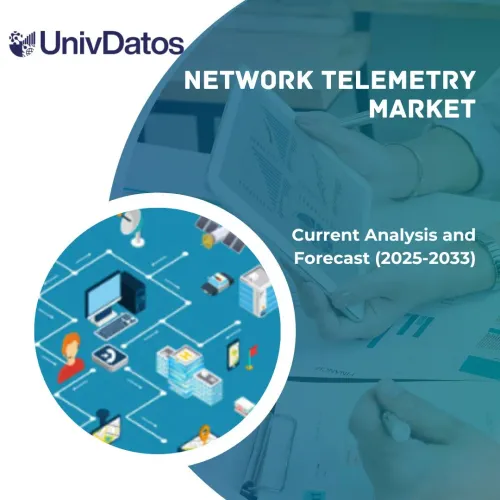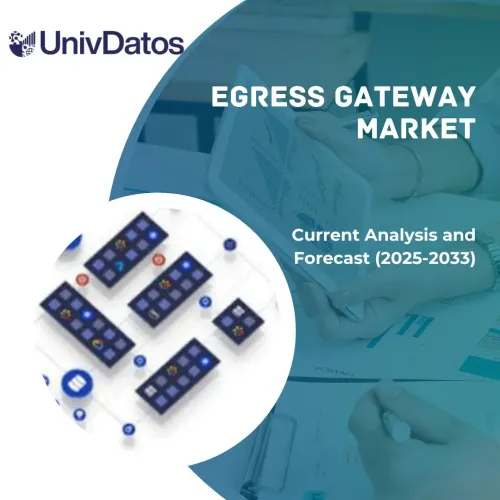- Home
- About Us
- Industry
- Services
- Reading
- Contact Us
Identity Verification Market: Current Analysis and Forecast (2021-2027)
Emphasis on Component (Solutions and Services); Type (Biometric and Non-Biometric); Deployment (On-premises and Cloud); Organization Size (Large Enterprises and SMEs); Industry (Information and Communication Technology, Banking and Financial Services, Government, Healthcare, and Others); and Region/Country
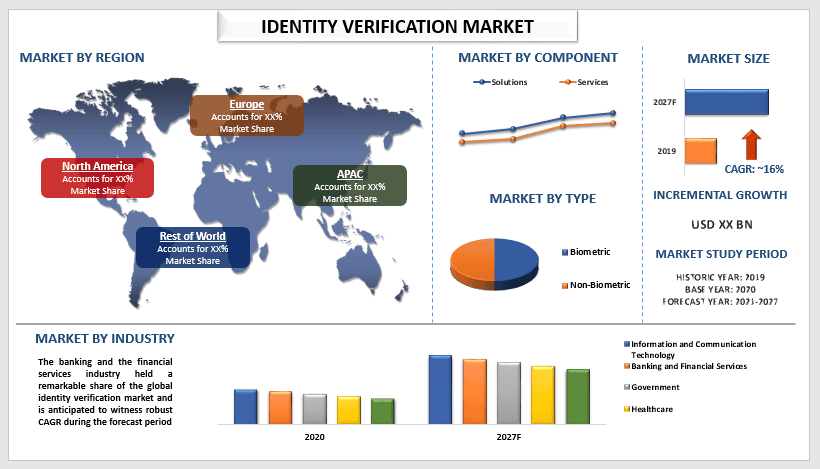
The global identity verification market is expected to register a CAGR of around 16% over the period of 2021-2027. The global identity verification market is rising on account of the growing digitalization, growing uses of digital identities among industries, and the increasing frequency of identity theft and cyberattacks. Increasing regulation and mandatory compliance with standards in all industries, especially in the financial sector, is expected to create many opportunities for market participants. Moreover, the increasing frequency of identity theft and cyberattacks are one of the most prominent factors driving the adoption of identity verification. For instance, according to the FBI’s 2021 Internet Crime Report, record 847,376 cybercrime complaints were reported to the FBI by the general public, up 7% from 2020. Identity verification is used by businesses to ensure that a user or customer provides information related to the identity of a real person. Verifying an individual’s identity is essential to prove that there is a real person behind the transaction or process. Scammers create fake profiles before misusing their business, such as defaulting online loans, creating multiple accounts to exploit promotion systems, or triggering affiliate rewards.
Experian Information Solutions Inc., GB Group plc, Equifax Inc., Mitek Systems Inc., LexisNexis Risk Solutions Group, Trulioo Information Services Inc., Acuant Inc., TransUnion LLC, Innovatrics s.r.o., and Applied Recognition Corp. are some of the key players in the market. Several M&As along with partnerships have been undertaken by these players to facilitate customers with hi-tech and innovative products/technologies.
Insights Presented in the Report
“Amongst component, the solutions segment held a prominent share in the market in 2020”
Among these, the solutions segment held a significant share of the global identity verification market in 2020 owing to the shift to digital transformation in various industries, the growing need to combat data breaches and fraud, increasing government support for data protection laws, and regulations, and requirements, requisite to fulfill KYC and AML compliance and easy onboarding of customers as well as employees.
Identity verification has become an integral part as the private and government sectors embrace more digital mediums, such as digital service access and borer control. “Smart Border Control” uses facial recognition for identity authentication and verification, and smart cities around the world use electronic ID cards (eID), biometric detection, and video analytics to verify identity.
“Amongst type, biometric segment accounted for a prominent share in the market in 2020”
Based on type, the market is divided into biometric and non-biometric. Biometric identity verification, the most common type of identity verification, establishes an individual’s legitimacy based on one or more biological characteristics. Fingerprints, retinal and iris patterns, and other biometric verification methods are commonly used. Biometric solutions use lock-and-capture mechanisms to verify an individual and grant access to a limited set of services. Therefore, the biometric identity verification segment has captured a significant share of the identity verification market in 2020 and is expected to continue growing at a robust growth rate during the forecasted period. Moreover, the increasing mobile and interpenetration rate in developing countries is also contributing to the growth of this market. For instance, according to the World Bank, in 2019, 64% of the population in Asia-Pacific was using the internet and this number grew to 69% in 2020.
“North America to witness significant growth during the forecast period”
North America held a prominent share of the market in 2020 and is expected to showcase a prominent growth rate during the forecast period. The growth of this market can be attributed to the presence of key market players in the region and the quick adoption of new technologies in the region. Additionally, factors such as the development of smart infrastructure, smart cities, government initiatives such as digital identity-based driver’s licenses, and increasing integration of various technologies such as AI, ML, and blockchain to secure digital identities are expected to grow in demand. Moreover, growing investment in AI is further influencing the growth of this market. For instance, according to the 2022 Stanford AI Index report, private venture investment in AI surged to USD 93.5 Bn in 2021, more than doubling from 2020. Further, initiatives taken by the government towards tackling identity-related frauds, such as compliance regulations initiated by countries, increasing demand for cloud identity verification solutions, and increasing identity-related cyber-attacks are driving the revenue growth in North America.
Reasons to buy this report:
- The study includes market sizing and forecasting analysis validated by authenticated key industry experts.
- The report presents a quick review of overall industry performance at one glance.
- The report covers an in-depth analysis of prominent industry peers with a primary focus on key business financials, product portfolio, expansion strategies, and recent developments.
- Detailed examination of drivers, restraints, key trends, and opportunities prevailing in the industry.
- The study comprehensively covers the market across different segments.
- Deep dive regional level analysis of the industry.
Customization Options:
Global identity verification market can further be customized as per the requirement or any other market segment. Besides this, UMI understands that you may have your own business needs, hence feel free to connect with us to get a report that completely suits your requirements.
Table of Content
Research Methodology for the Identity Verification Market Analysis (2021-2027)
Analyzing the historical market, estimating the current market, and forecasting the future market of the global identity verification market were the three major steps undertaken to create and analyze the adoption of identity verification in major regions globally. Exhaustive secondary research was conducted to collect the historical market numbers and estimate the current market size. Secondly, to validate these insights, numerous findings and assumptions were taken into consideration. Moreover, exhaustive primary interviews were also conducted, with industry experts across the value chain of the global identity verification market. Post assumption and validation of market numbers through primary interviews, we employed a top-down/bottom-up approach to forecasting the complete market size. Thereafter, market breakdown and data triangulation methods were adopted to estimate and analyze the market size of segments and sub-segments of the industry pertains to. Detailed methodology is explained below:
Seek More Details About Research Methodology
Analysis of Historical Market Size
Step 1: In-Depth Study of Secondary Sources:
Detail secondary study was conducted to obtain the historical market size of the identity verification market through company internal sources such as annual report & financial statements, performance presentations, press releases, etc., and external sources including journals, news & articles, government publications, competitor publications, sector reports, third-party database, and other credible publications.
Step 2: Market Segmentation:
After obtaining the historical market size of the identity verification market, we conducted a detailed secondary analysis to gather historical market insights and share for different segments & sub-segments for major regions. Major segments included in the report as the component, type, deployment, organization size, and industry. Further country-level analyses were conducted to evaluate the overall adoption of testing models in that region.
Step 3: Factor Analysis:
After acquiring the historical market size of different segments and sub-segments, we conducted a detailed factor analysis to estimate the current market size of the identity verification market. Further, we conducted factor analysis using dependent and independent variables such as component, type, deployment, organization size, and industry of identity verification. A thorough analysis was conducted for demand and supply-side scenarios considering top partnerships, mergers and acquisitions, business expansion, and product launches in the identity verification market sector across the globe.
Current Market Size Estimate & Forecast
Current Market Sizing: Based on actionable insights from the above 3 steps, we arrived at the current market size, key players in the global identity verification market, and market shares of the segments. All the required percentage shares split, and market breakdowns were determined using the above-mentioned secondary approach and were verified through primary interviews.
Estimation & Forecasting: For market estimation and forecast, weights were assigned to different factors including drivers & trends, restraints, and opportunities available for the stakeholders. After analyzing these factors, relevant forecasting techniques i.e., top-down/bottom-up approach was applied to arrive at the market forecast about 2027 for different segments and sub-segments across the major markets globally. The research methodology adopted to estimate the market size encompasses:
- The industry’s market size, in terms of revenue (USD) and the adoption rate of the identity verification market across the major markets domestically
- All percentage shares, splits, and breakdowns of market segments and sub-segments
- Key players in the global identity verification market in terms of solutions offered. Also, the growth strategies adopted by these players to compete in the fast-growing market
Market Size and Share Validation
Primary Research: In-depth interviews were conducted with the Key Opinion Leaders (KOLs) including Top Level Executives (CXO/VPs, Sales Head, Marketing Head, Operational Head, Regional Head, Country Head, etc.) across major regions. Primary research findings were then summarized, and statistical analysis was performed to prove the stated hypothesis. Inputs from primary research were consolidated with secondary findings, hence turning information into actionable insights.
Split of Primary Participants in Different Regions
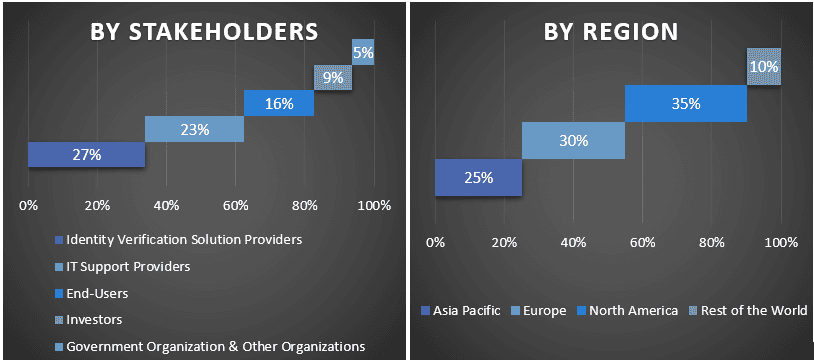
Market Engineering
Data triangulation technique was employed to complete the overall market estimation and to arrive at precise statistical numbers for each segment and sub-segment of the global identity verification market. Data was split into several segments & sub-segments post studying various parameters and trends in the areas of the component, type, deployment, organization size, and industry in the global identity verification market.
The main objective of the Global Identity Verification Market Study
The current & future market trends of the global identity verification market were pinpointed in the study. Investors can gain strategic insights to base their discretion for investments from the qualitative and quantitative analysis performed in the study. Current and future market trends were determined the overall attractiveness of the market at a regional level, providing a platform for the industrial participant to exploit the untapped market to benefit as a first-mover advantage. Other quantitative goals of the studies include:
- Analyze the current and forecast market size of the identity verification market in terms of value (USD). Also, analyze the current and forecast market size of different segments and sub-segments
- Segments in the study include areas of the component, type, deployment, organization size, and industry
- Define and analysis of the regulatory framework for the identity verification market industry
- Analyze the value chain involved with the presence of various intermediaries, along with analyzing customer and competitor behaviors of the industry
- Analyze the current and forecast market size of the identity verification market for the major region
- Major countries of regions studied in the report include Asia Pacific, Europe, North America, and Rest of the World
- Company profiles of the identity verification market and the growth strategies adopted by the market players to sustain in the fast-growing market
- Deep dive regional level analysis of the industry
Related Reports
Customers who bought this item also bought



